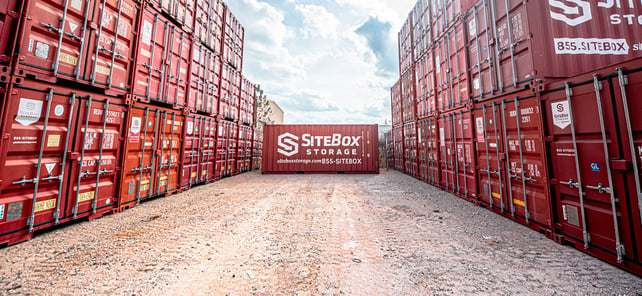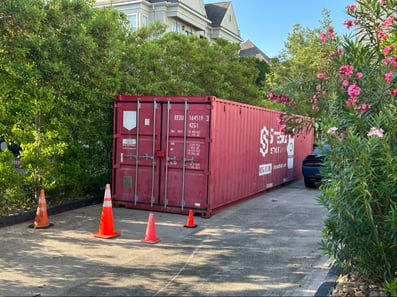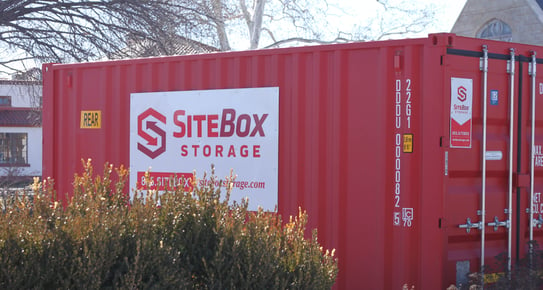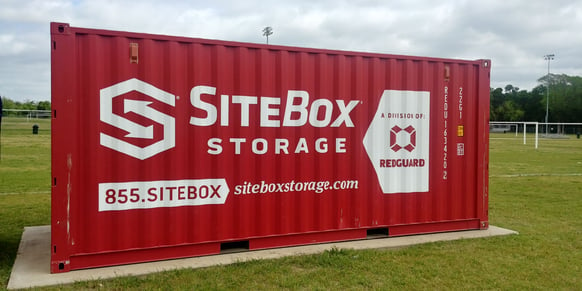Choosing the Right Size Portable Storage Container

So you've decided it's finally time to get a portable storage container. Maybe you're moving to a new apartment, handling a renovation, or your business needs extra space for inventory and tools.
Good call.
Up to 65% of individuals moving prefer portable containers over traditional self-storage options. The convenience, security, and flexibility beat driving back and forth to some storage facility.
What isn't straightforward is figuring out exactly what size you need. Without guidance, it's easy to underestimate and discover the unit is too small, or think you need way more space and get stuck with something too big in your driveway.
With decades in the portable storage industry, we have the experience to help you find a container that's "just right."
Overview of Portable Storage Container Sizes
Common portable storage container sizes range from 10 to 40 feet in length. Most containers are made of durable steel and designed for weather resistance. The transportable nature means delivery right to your property: house, apartment, job site, or business location.
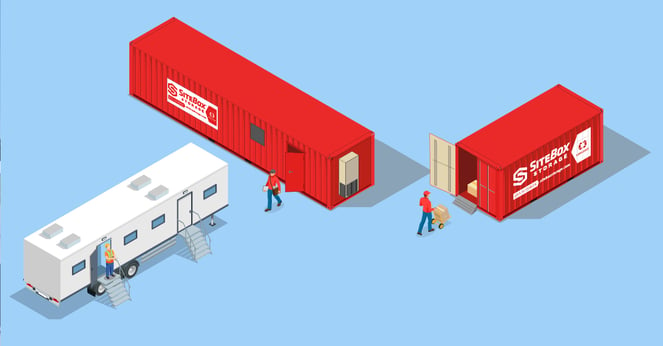
The versatility is impressive. Temporary storage during moves, protecting furniture during renovations, business expansion, college students between dorms... containers handle it all.
Container dimensions are typically given in length (10', 20', 40'), width (usually 8'), and height (8' to 9.5'). Interior volume in cubic feet and weight capacity (several thousand pounds typically) matter when planning what you'll store.
Standard Sizes of Storage Containers
10-foot containers offer roughly 539 cubic feet. Standard 10-foot containers account for nearly 28% of rentals in urban areas. They typically hold contents of a studio or one-bedroom apartment: furniture, boxes, belongings, some appliances.
16-foot containers are the most common size, used by 42% of renters. This size accommodates a two-bedroom apartment or small house worth of household goods comfortably.
20-foot containers are popular for larger needs, preferred by approximately 37% of customers. They offer around 1,160 cubic feet... enough for a three-bedroom house or substantial commercial inventory.

40-foot containers handle serious storage with roughly 2,390 cubic feet of volume. Nearly 80% of businesses find that a 40-foot container meets their complete storage requirements.
Comparing 10ft, 20ft, and 40ft Containers
10-foot containers work for studio apartments, college students, or businesses with minimal equipment. Compact and convenient for urban areas with limited property space. Lower price point.
20-foot containers are the workhorse for residential moves and medium businesses. Three-bedroom house? Handles it. Small business inventory? Fits nicely. Most versatile size.
40-foot containers serve large homes, major business operations, construction companies. Multiple sofas, bedroom furniture, appliances, boxes... a 40-footer handles it all.
The size affects delivery fees and driveway space needed. Bigger means higher costs but potentially better value per cubic foot if you need the capacity.
Choosing the Right Size for Your Needs
How much stuff do you have? Do a complete inventory. Count boxes, note dimensions, list furniture with measurements. Include appliances, tools, equipment. Calculate cubic feet by multiplying width x height x depth, then total everything.
What's the single biggest thing? Sometimes you can skip math by identifying your longest, tallest, and widest items. Got 30-foot supplies? Don't get a 20-foot container.
How much access do you need? When storing items you need regularly, you need room to move around. Always allow pathways throughout your container.
How much space do you have on site? Don't fall in love with a 40-foot container if your property can't accommodate it. Mix and match various sizes to get storage you need with a footprint that works.
Weight Capacity Considerations
Most containers handle several thousand pounds. Exact capacity depends on construction and condition.
Household goods usually aren't a problem. Furniture, boxes, clothing, typical appliances rarely exceed weight limits.
Commercial equipment and tools require more attention. Industrial machinery, large quantities of wood, heavy appliances add up fast. Get an estimate if storing particularly heavy items.
Properly distribute weight throughout the container. Don't pile everything heavy on one end. Use tie-down rings to secure items during delivery and transit.
Storage Container Dimensions Explained
Exterior dimensions determine if a container fits your property. A 20-foot container is 20' long, 8' wide, 8 to 8.5' tall externally. Account for delivery truck clearance.
Interior dimensions are slightly smaller due to wall thickness. That 20-footer might have interior length of 19'4", width of 7'8", height of 7'10". These matter for what actually fits inside.
Door dimensions affect loading. Standard cargo doors open about 7'8" wide and 7'6" tall. Verify door size accommodates your biggest pieces.
Cubic feet calculation: multiply interior length x width x height for total volume.
Custom Size Options Available
Many providers offer custom modifications. Need specific interior height? Want additional doors? Require interior shelving? Custom options exist, though they cost more.
Pre-designed layouts offer middle ground. At SiteBox Storage, we offer nine off-the-shelf layouts: 10' Laboratory, 20' Mobile Office with Restroom, 40' Mobile Office with Restroom, 20' Restroom Unit, 40' Restroom Unit with Locker Rooms, 20' Data Center, 20' Guard Shack, 40' Tool Crib, and 40' Multi-Section.
Multiple containers configured together create larger spaces. Two 20-footers might work better than one 40-footer depending on property layout.
Common Uses for Different Container Sizes
10-foot: Studio apartments, one-bedroom moves, college students, small business equipment, construction tools for smaller crews, seasonal inventory for small retailers.
20-foot: Three-bedroom houses, small to medium business inventory, construction site storage, retail overflow, vehicle storage, appliance and furniture storage during renovations.
40-foot: Large homes (4+ bedrooms), major business inventory, construction companies with extensive equipment, commercial warehouse overflow, multiple vehicles, large-scale renovations.
Cost Implications Based on Size
A 10-foot container might run $100 to $150 monthly. A 20-footer could cost $150 to $250 monthly. A 40-footer might hit $250 to $400+ monthly. Prices vary by location... California and high-cost areas charge more.
Delivery fees often stay consistent regardless of size. Some companies charge flat fees, others base on distance.
Purchase prices follow similar scaling. Used costs less than new. Condition, age, and features affect pricing.
Calculate cost per cubic foot when comparing sizes. Sometimes larger containers offer better value if you need the space. But paying for unused volume wastes money.
Delivery and Placement Considerations
Access requirements vary by size. Delivery trucks typically need 100+ feet of straight clearance. Confirm your property access works before committing.

Placement location should be level and stable. Driveways work if adequate size. Yards need solid ground. Avoid low spots where water pools. Some areas have restrictions on container placement.
Service area affects availability. Confirm your location falls within delivery area. Rural locations might have limited options or higher fees.
Customer service matters when coordinating delivery. Good companies provide clear communication about windows, placement instructions, and site prep needed.
FAQ
What are common sizes for portable storage containers? Common sizes range from 10 to 40 feet. Standard options include 10', 16', 20', and 40' containers. Width is typically 8', height ranges from 8' to 9.5'.
How do I choose the right size storage container? Inventory everything you need to store and calculate cubic feet. Consider your largest items and access needs. A 10' holds a studio apartment, 20' fits a three-bedroom house, 40' handles large homes or commercial inventory.
What's the size of a 20-foot storage container? 20' long x 8' wide x 8 to 8.5' tall externally. Interior dimensions are approximately 19'4" x 7'8" x 7'10", providing around 1,160 cubic feet.
Can I customize the size of a portable storage container? Many providers offer custom modifications including specific features, additional doors, or modified dimensions. Some offer pre-designed specialty layouts.
How much space does a standard storage container take up? A 10' container occupies 80 square feet, 20' takes 160 square feet, 40' requires 320 square feet. Add clearance for delivery and access.
What's the difference between small and large storage containers? Small (10') work for studios or minimal belongings. Medium (20') handle average homes and moderate business needs. Large (40') accommodate big homes or extensive inventory.
Are there sizes of storage containers for vehicles? 20' and 40' containers accommodate vehicles. A 20' fits most cars or motorcycles. A 40' holds multiple vehicles or larger trucks. Verify door dimensions first.

How tall are typical portable storage containers? Standard containers are 8 to 8.5' tall externally with interior height of 7'8" to 7'10". High-cube containers offer 9.5' external height with interior around 8'8".
What can fit in a 10-foot storage container? Contents of a studio or one-bedroom apartment—approximately 539 cubic feet. Includes bed, small sofa, dresser, boxes, maybe a few appliances.
Do different companies offer different container sizes? Yes, sizes vary by provider. Most offer standard 10', 20', 40' options. Some provide 16' or other sizes. Custom modifications differ between providers.
